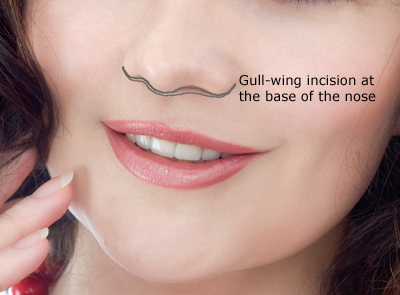Surgical Lip Augmentation

For some people, lip augmentation should be permanent, and surgery or implantation of permanent fillers is appropriate. As dermal fillers have improved over time, however, these options are no longer as popular as they once were.
One reason that I often favor long lasting temporary solutions (dermal fillers such as Juvederm or Restylane and occasionally Perlane) is that the lips change over time. As we age, the lips undergo multiple transformations in shape, size, and definition. Lip enhancement that is aesthetic and attractive at 25 years of age may appear odd at 45 and ungainly at 55.
Another reason is changes in our concepts of beauty. We may prefer a particular look this year, but favor a different contour and shape to our lips the next. Since surgery may be irreversible and permanent implants are more likely to leave altered anatomy and scar tissue behind even if removed, younger patients may desire a less permanent change.
However, these surgeries can produce fantastic results. When appropriate, implants of alloderm, dermal fat, Gore-tex, and even newer products still being researched can produce a pretty pout to the lips and are long lasting. Synthetic implants can often be removed without significant difficulty; fat grafts can occasionally be trickier to remove, depending on a host of factors.
 Another implant, which is less commonly used, is silicone microdroplet injection for augmentation. Currently, there is a medical grade silicone, Silikon 1000, which can be injected into the lips much like dermal filler for augmentation. However, the product is not FDA-approved for cosmetic use. In addition, it should be injected in small, controlled amounts over multiple sessions (as many as five) to prevent granuloma (inflammatory lump) formation and migration, among other things. Yet the product remains a viable alternative for permanent lip augmentation. Be sure to contact your facial plastic surgeon for a full consultation to see if this is an option for you.
Another implant, which is less commonly used, is silicone microdroplet injection for augmentation. Currently, there is a medical grade silicone, Silikon 1000, which can be injected into the lips much like dermal filler for augmentation. However, the product is not FDA-approved for cosmetic use. In addition, it should be injected in small, controlled amounts over multiple sessions (as many as five) to prevent granuloma (inflammatory lump) formation and migration, among other things. Yet the product remains a viable alternative for permanent lip augmentation. Be sure to contact your facial plastic surgeon for a full consultation to see if this is an option for you.
Common surgical advancement techniques also include the V-Y Advancement or augmentation cheiloplasty, which has been around for many years. Essentially, two “V” shaped incisions coming together to form a “W” are made on the inside surface of the lip, then the lip is advanced outwards and the incisions closed in the shape of two “Y’s.” The goal of the V-Y Advancement is to increase the projection and bulk of the central lip, although the lateral portions of the lips can also be augmented. Scarring does not appear to be significant or create much firmness for patients.
Another technique used in lip enhancement is the nasal base resection, which is used for those with a large space between the upper lip and nose. A “sea-gull” shaped elliptical incision just at the base of the nose is made to remove skin before closure. This gently rotates the upper lip outwards while balancing the proportions of the face to benefit the appearance of the lips.
After lip surgery, your lips may feel tight for several weeks. You should rest your lips as much as possible in the first ten days after surgery and avoid smoking. If you have a history of cold sores, be sure to tell your surgeon so that he or she may start you on antiviral medication before surgery. Some numbness should be expected after surgery, and may last up to six months.
So is surgical lip enhancement for you? The more you know, the easier your decision. I recommend contacting your facial plastic surgeon in order to discuss your options and what might benefit you the most.


